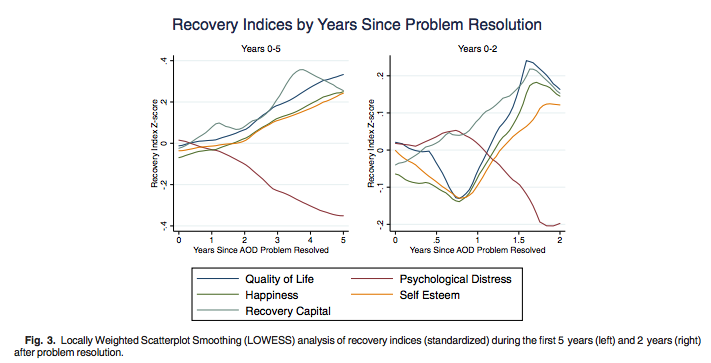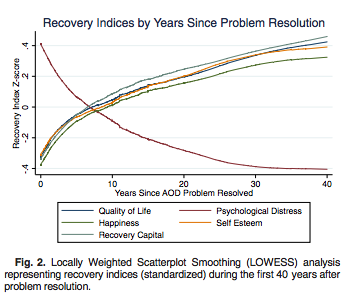Increasing the years increases the happiness
Much of the treatment and recovery literature has focused solely on abstinence. This national recovery study examined changes in indices of quality of life, functioning and well-being as people progress in recovery with some notable differences observed across time, by race/ethnicity, and by primary substance.
WHAT PROBLEM DOES THIS STUDY ADDRESS?
The data is derived from the National Recovery Study, a nationally-representative dataset of 2,002 US adults who “used to have a problem with alcohol or drugs but no longer do.”
HOW WAS THIS STUDY CONDUCTED?
The data is derived from the National Recovery Study, a nationally-representative dataset of 2,002 US adults who “used to have a problem with alcohol or drugs but no longer do.”
- READ MORE ON STUDY METHODS
-
This group was then characterized in detail, with 58.5% identifying alcohol as their primary substance of problematic use, 11% cannabis, 10% cocaine. Participants also reported on the onset of their substance use, onset of problematic use and when they resolved their alcohol or other drug problem. From these data, authors calculated how long it has been since they resolved one or more substance use problems. The survey also included details about their history of participation in addiction treatment and other recovery supports services. Authors focused here on measures of psychological distress (the Kessler-6 measure), quality of life (the EUROHIS-QOL measure), recovery capital/resources (10-item Brief Assessment of Recovery Capital), happiness and self-esteem (a one item Likert scale 1-5). In this study, two different time horizons were examined which contained overlapping subsets of respondents , those who reported resolving their problematic alcohol or other drug use within the last 40 years, and those resolving problematic use in the last five years (approximately 30% of the respondents).
WHAT DID THIS STUDY FIND?
During the first year of recovery, there was initial stability followed by significant drops in self-esteem and happiness – with even greater initial declines seen in women (relative to men), mixed race/native Americans (as compared with whites) and in those reporting opioid or other primary problematic substance (as compared with alcohol or marijuana). Happiness and self-esteem scores did not, on average, start to increase until almost a year following resolution of problematic use. However, the Quality of Life scores were still considerably higher at one year of recovery than that seen in a different depressed US population captured in a primary care setting.

There were steep increases in indices of wellbeing and significant decrease of distress during the first six years of recovery, followed by shallower increases over the 40-year horizon. Five years into recovery, the majority of the gains (decreased psychological distress, increased quality of life, happiness, self-esteem) had been obtained with more gradual improvements in the subsequent years.

Quality of Life measures seem to normalize at approximately 15 years of recovery – Fifteen years after the resolution of problem drinking, the Quality of Life scores reached the levels seen in the general population in a healthy sample.
Recovery Capital is proportionately lower for those with histories of problematic opioid or stimulant use. Though the ability to rebuild their lives after resolving problematic use is appears potentially more challenging than for those with problem alcohol or cannabis use, these individuals do accrue recovery capital at a faster rate, and have comparable recovery capital by three years after resolution of problematic use.
Racial and gender differences: Women consistently showed lower quality of life measures and self esteem scores, and higher psychological distress, than men, regardless of the time since problem resolution. In contrast, black Americans had greater self-esteem and marginally greater happiness than white Americans.
WHAT ARE THE IMPLICATIONS OF THE STUDY FINDINGS?
Despite an initial decrease in wellbeing in the first months into recovery, there is a steady improvement in quality of life, happiness, self-esteem measures over the years with substantial decreases in psychological distress. Of note, the drop in happiness and self-esteem after about five months of recovery may reflect a period of deeper realization and more solemn contemplation once the brain has begun to clear that evokes feelings of remorse and guilt about the past and anxiety about the future. This fits the anecdotal picture for many and it may take individuals several months to begin to accept this new reality and begin to address it.
The good news appears to be that after about one year of recovery things start to look a bit sunnier. In fact, most of the substantial positive gains are obtained between one and five years into recovery, but continue to increase, and by fifteen years, on average, those in recovery have normalized their quality of life relative to those in the population without drug/alcohol problem histories. Some groups of individuals, though, may find it especially more challenging in the early phases of recovery such as those whose primary substance is opioids or methamphetamine and those of more marginalized racial/ethnic identities (e.g., Native Americans). These individuals may require extra initial support and recovery resources to enhance their well-being and sustain recovery over time.
- LIMITATIONS
-
- This is a cross-sectional survey. Data is presented in years since problem resolution suggesting a longitudinal picture; in fact, different populations are being compared. Specifically, because different individuals in the sample have gotten into recovery at different times during the past 40 years, the conditions during which they suffered from their alcohol/drug problem and achieved recovery may be quite different. For example, cannabis pharmacology and potency has changed significantly more recently, making recent users potentially not comparable to those who have not had problem use in decades.
- This is a retrospective study, with some of the self-reports on substance use being reported decades later, leading potentially to reporting inaccuracies as compared with a prospective study with shorter recall periods.
BOTTOM LINE
- For individuals & families seeking recovery: Given the many attempts it takes to obtain sobriety or enter recovery, emphasizing the continued gains obtained with sustained recovery may help provide additional motivation for recovery. It may also be important to point out that many experience an initial dip in well-being, encouraging them to persist through this difficult time during the first year of recovery, with optimism toward likely much better times ahead. Speaking to those entering recovery about the things that really matter to people’s life experience (wellbeing, distress, happiness, self-esteem) may uniquely motivate individuals much more than the more clinical concerns.
- For scientists: Inclusion of measures of wellbeing in research studies, particularly long-term trials or those with long-term follow-up, may help inform the field as to the quality of life and well-being changes that emerge beyond mere abstinence/reduced substance use. These may serve as important motivators for change. As this is a cross-sectional study, including these measures in a prospective study might allow a careful analysis as to the mechanisms of the change that allow individuals to view themselves and their lives differently during recovery.
- For policy makers: Measures of distress, self-esteem, happiness, and the like, are under-utilized in public health and clinical research. Greater inclusion of these in research studies may help inform the field as to the dynamic nature and magnitude of changes in these indices of well-being that emerge beyond mere abstinence/reduced substance use. More knowledge of these may serve as important motivators for change.
- For treatment professionals and treatment systems: Emphasizing and clinically monitoring indices of wellbeing and exploring feelings of psychological distress and decreased self-esteem and happiness may help alert clinicians to potential negative shifts which can be addressed. Findings in this study suggest things may get worse before they get better but the future looks better if people can navigate through the first year in particular. Focusing on the continued gains to be achieved with prolonged recovery may provide individuals with added motivation to work through some of early the challenging experiences including remorse and guilt about the past and anxiety about “catching up” and the future more globally.
CITATIONS
Kelly, J. F., Greene, M. C., & Bergman, B. G. (2018). Beyond Abstinence: Changes in Indices of Quality of Life with Time in Recovery in a Nationally Representative Sample of US Adults. Alcoholism: Clinical and Experimental Research, 42(4), 770-780.

